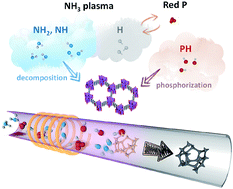Direct conversion of metal organic frameworks into ultrafine phosphide nanocomposites in multicomponent plasma for wide pH hydrogen evolution†
Abstract
Benefiting from tailorable properties through electronic states, chemical composition and crystal structures, transition metal phosphides (TMPs) present a great impetus for electrocatalytic water splitting. However, most TMP nanostructures are prepared via rigorous synthetic methods and harmful precursors, restricting their applications. Meanwhile, the rational design of structural characteristics and surface modification of TMPs needs to be considered to improve their catalytic activity and durability in both alkaline and acidic media. Here we report a simultaneous MOF decomposition and phosphorization strategy in multicomponent NH3 plasma to prepare nickel phosphide encapsulated in N-doped carbon layers (Ni12P5@NC). The combination of the high chemical reactivity and low thermal effect of plasma enables low-temperature phosphorization with red phosphorus as the P source. Carambola-like Ni12P5@NC exhibits low overpotential (50 mV in alkali and 82 mV in acid, 20 mA cm−2) and superior operational stability, showing promising application toward water electrolysis.



 Please wait while we load your content...
Please wait while we load your content...